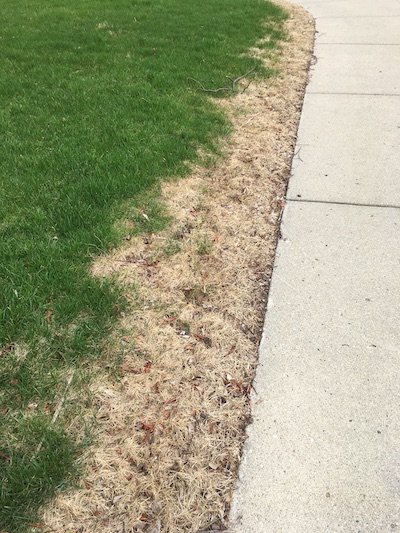
One of the easiest ways to reduce the need for deicers and ice melts is to keep sidewalks and driveways clear of snow. (C) Jo Ellen Meyers Sharp
As we head into winter, there are a few landscape safety tips to keep in mind.
Start with using caution with deicers or ice melts. Many of these products are salt-based, which is damaging to lawns, shrubs, perennials and trees.
Consider where you’ll be using the ice melt. Is it in an area where there’s little runoff from hard surfaces to landscaped beds? Also don’t over apply either product. Smaller amounts of ice melt generally do as good of a job as a heavy application. It just might take a bit longer.

Water from snow or ice melted with deicers can kill grass. Use caution when shoveling snow that has been treated with ice melts onto the lawn or landscape plants. (C) Photo Jo Ellen Meyers Sharp
Be careful where you shovel snow that has been treated with ice melt. Throwing it onto landscaped beds runs the risk of exposing plants to the chemicals. These products can burn lawns, foliage, stems, branches and roots as well as contaminate the soil. Salt-based products also can be harmful to the paws of dogs.
There are deicers with different formulations labeled safe for pets and plants. These are usually a little more expensive than the salt-based products. Non-clumping, clay kitty litter also works well, as much to provide traction as to help melt ice. Keeping sidewalks and driveway free of snow goes a long way to reduce or eliminate ice build up.
Try to avoid walking on frosted or frozen grass. Foot traffic breaks grass blades and compacts the soil. There’s not much we can do about dog paws on the lawn. In spring, consider over seeding in those trekked on places.
Protect plants that are likely to get sprayed with slush from treated roads. A snow fence or burlap screen work well for this.
We don’t usually get the snow load that our neighbors in nearby states get. But if we do, pay attention to bending or bowed branches, especially evergreens like arborvitae. If you feel you must remove snow from an evergreen, use your hand and arm in an upward sweeping motion. A broom works well, too, but use it gently. Do not try to remove ice coatings from plants.
Branches weighed down by snow for several days may be damaged. Snow load on deciduous shrubs and trees may cause limbs and branches to break. It may be necessary to work with a certified arborist. If the limb tears bark from the tree, the injury could be fatal. Branches weakened by insects or disease are especially vulnerable in all kinds of storms. This is one reason it’s a good practice to have your trees inspected periodically by a certified arborist (treesaregood.org).
To the readers: Merry Christmas. Thank you for reading the column, sending questions and comments. Please keep it up. All the best for 2018.